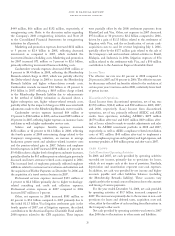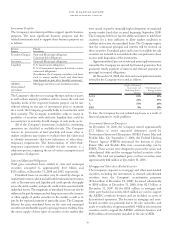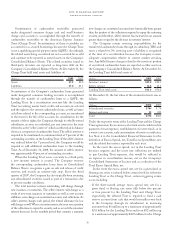American Express 2008 Annual Report Download - page 33
Download and view the complete annual report
Please find page 33 of the 2008 American Express annual report below. You can navigate through the pages in the report by either clicking on the pages listed below, or by using the keyword search tool below to find specific information within the annual report.
2008 financial review
american express company
At December 31, 2008, the Company’s remaining asset-
backed securities were rated as follows:
Rating Percentage of Total
AAA 79%
AA 9%
A3%
BBB 7%
BB 2%
Of the $288 million in mortgage and other asset-backed
securities, $75 million of mortgage-backed securities are
classified as available-for-sale within continuing operations
and are rated AAA. There were no gross unrealized losses
at December 31, 2008, related to the asset-backed securities
classified as available-for-sale.
Money Market Mutual Fund
The Company owned a $500 million investment in the Primary
Reserve Fund (the Fund), a money market fund, at the time the
net asset value of the Fund fell below $1 per share in September
2008. The Company recorded a loss of $15 million related to
its investment in the Fund in September 2008. The Company
received approximately $390 million from the Fund since it filed a
redemption order with Reserve, the Fund sponsor, in September
2008. Redemptions have been suspended and the timing of receipt
of the remaining proceeds cannot be determined at this time.
The remaining amount due from the Fund is recorded in other
receivables on the Company’s Consolidated Balance Sheets.
With the exception of its exposure to the Fund, the
Company did not experience any defaults or events of default,
or determine it would not receive timely contractual payments
of interest and repayment of principal on any of its holdings in
its investment portfolios.
Fair Value Measurements
Effective January 1, 2008, the Company partially adopted SFAS
No. 157 for its financial assets and liabilities that are accounted
for at fair value. Refer to Notes 1 and 17 to the Consolidated
Financial Statements for further details of the Company’s fair
value measurements.
certain legislative, regulatory and
other developments
As a participant in the financial services industry, the Company
is subject to a wide array of regulations applicable to its
businesses. Recently, the Company became a bank holding
company, thereby resulting in the Federal Reserve Board’s
becoming the Company’s primary regulator. As such, the
Company is subject to the Federal Reserve Board’s regulations
and policies, including its regulatory capital requirements. The
Company is in the process of taking various actions to facilitate
its compliance with the Federal Reserve Board’s regulatory
framework. In addition, the extreme disruptions in the capital
markets since mid-2007 and the resulting instability and
failure of numerous financial institutions, have led to numerous
proposals for changes in the financial services industry, including
significant additional regulation and the formation of potential
“super regulators” that combine the scope and authority of
various existing regulatory bodies. Regulatory changes could
lead to business disruptions, impact the scope or profitability
of the Company’s business activities, require the Company to
change certain of its business practices and could expose it to
additional costs (including increased compliance costs).
In recent years, there has been a heightened level of
regulatory attention on banks and the payments industry in
many countries. Among other recent regulatory developments,
in December 2008, federal bank regulators in the United States
adopted amendments to the rules regarding Unfair or Deceptive
Acts or Practices (UDAP) and Truth in Lending that restrict
certain credit and charge card practices and require expanded
disclosures to consumers. Similar legislative initiatives have been
proposed. The regulatory amendments, which become effective
July 1, 2010, include, among other matters, rules relating to
the imposition by card issuers of interest rate increases on
outstanding balances and the allocation of payments in respect
of outstanding balances with different interest rates. The
Company continues to assess the impact of the amendments on
its business and operations and is evaluating offsetting actions
to mitigate their impact. In the event any actions undertaken by
the Company to offset the impact of the amendments are not
effective, the amendments will likely have a material adverse
effect on the Company’s results of operations.
The credit and charge card industry also faces continuing
scrutiny in connection with the fees merchants are charged to
accept cards. Although investigations into the way bankcard
network members collectively set the “interchange” (i.e., the fee
paid by the bankcard merchant acquirer to the card issuing bank
in “four party” payment networks, like Visa and MasterCard)
had largely been a subject of regulators outside the United
States, a bill was introduced in Congress in early 2008 designed
to give merchants antitrust immunity to negotiate interchange
collectively with Visa and MasterCard. Although unlike the
Visa and MasterCard networks, the American Express network
does not collectively set interchange fees, antitrust actions and
government regulation of the bankcard networks’ pricing could
ultimately affect all networks.
The Financial Accounting Standards Board is considering
whether to propose amendments that would significantly affect
the accounting for off-balance sheet securitization activities,
which could, if ultimately adopted, result in the Company having
to consolidate approximately $29 billion of assets and liabilities of
the American Express Credit Account Master Trust (the Lending
Trust). This consolidation would also require the Company to
31
























